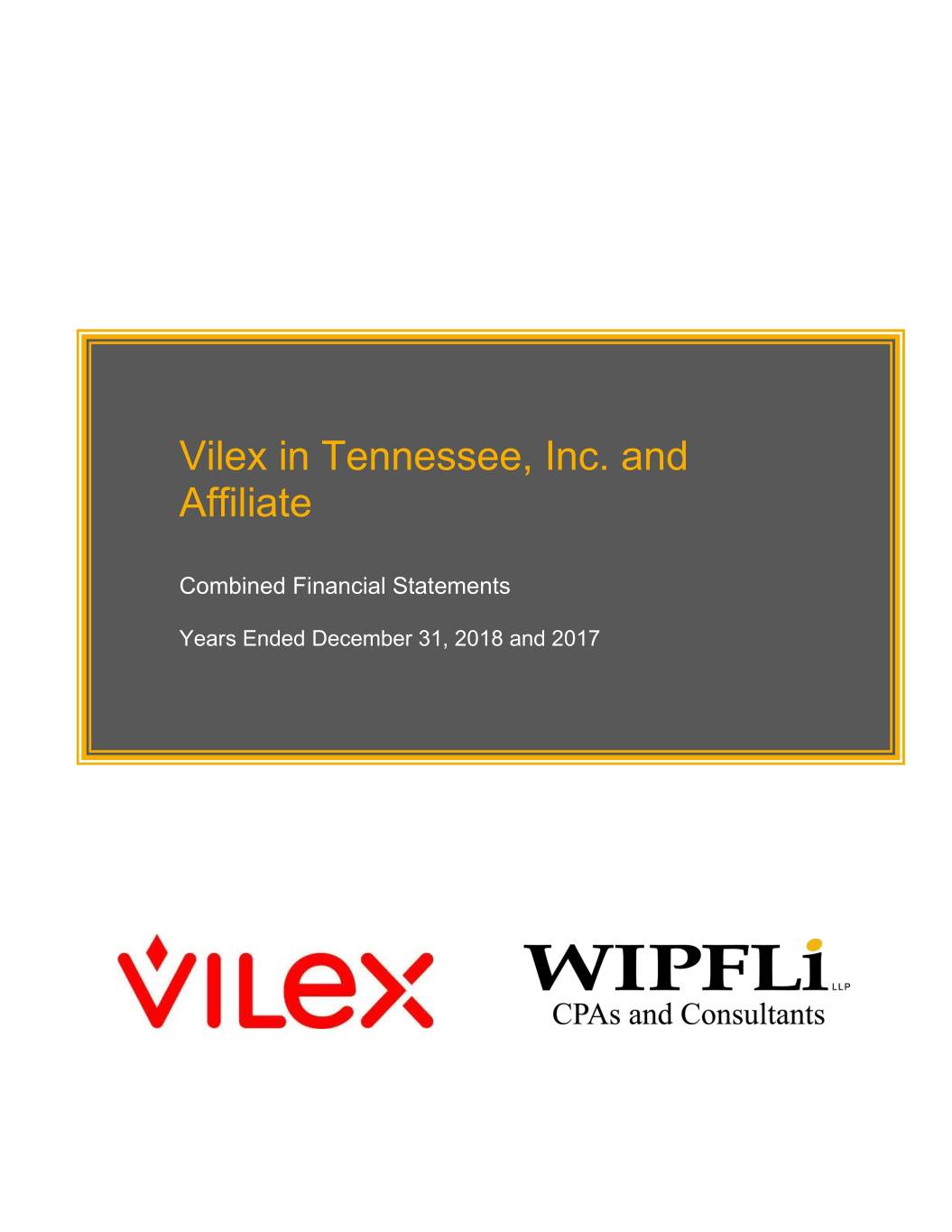
Vilex in Tennessee, Inc. and Affiliate Combined Financial Statements Years Ended December 31, 2018 and 2017

Independent Auditor's Report Board of Directors Vilex in Tennessee, Inc. and Affiliate McMinnville, Tennessee Report on the Combined Financial Statements We have audited the accompanying combined financial statements of Vilex in Tennessee, Inc. and Affiliate, which comprise the combined balance sheets as of December 31, 2018 and 2017, and the related combined statements of income, stockholders' equity and members' deficit, and cash flows for the years then ended and the related notes to the combined financial statements. Management's Responsibility for the Combined Financial Statements Management is responsible for the preparation and fair presentation of these combined financial statements in accordance with accounting principles generally accepted in the United States; this includes the design, implementation, and maintenance of internal control relevant to the preparation and fair presentation of combined financial statements that are free from material misstatement, whether due to fraud or error. Auditor's Responsibility Our responsibility is to express an opinion on these combined financial statements based on our audits. We conducted our audits in accordance with auditing standards generally accepted in the United States. Those standards require that we plan and perform the audits to obtain reasonable assurance about whether the combined financial statements are free from material misstatement. An audit involves performing procedures to obtain audit evidence about the amounts and disclosures in the combined financial statements. The procedures selected depend on the auditor’s judgment, including the assessment of the risks of material misstatement of the combined financial statements whether due to fraud or error. In making those risk assessments, the auditor considers internal control relevant to the entity’s preparation and fair presentation of the combined financial statements in order to design audit procedures that are appropriate in the circumstances, but not for the purpose of expressing an opinion on the effectiveness of the entity’s internal control. Accordingly, we express no such opinion. An audit also includes evaluating the appropriateness of accounting policies used and the reasonableness of significant accounting estimates made by management, as well as evaluating the overall presentation of the combined financial statements. We believe that the audit evidence we have obtained is sufficient and appropriate to provide a basis for our audit opinion. Opinion In our opinion, the combined financial statements referred to above presents fairly, in all material respects, the financial position of Vilex in Tennessee, Inc. and Affiliate as of December 31, 2018 and 2017, and the combined results of their operations and their cash flows for the years then ended in accordance with accounting principles generally accepted in the United States. Wipfli LLP July 30, 2019 Lincolnshire, Illinois 1
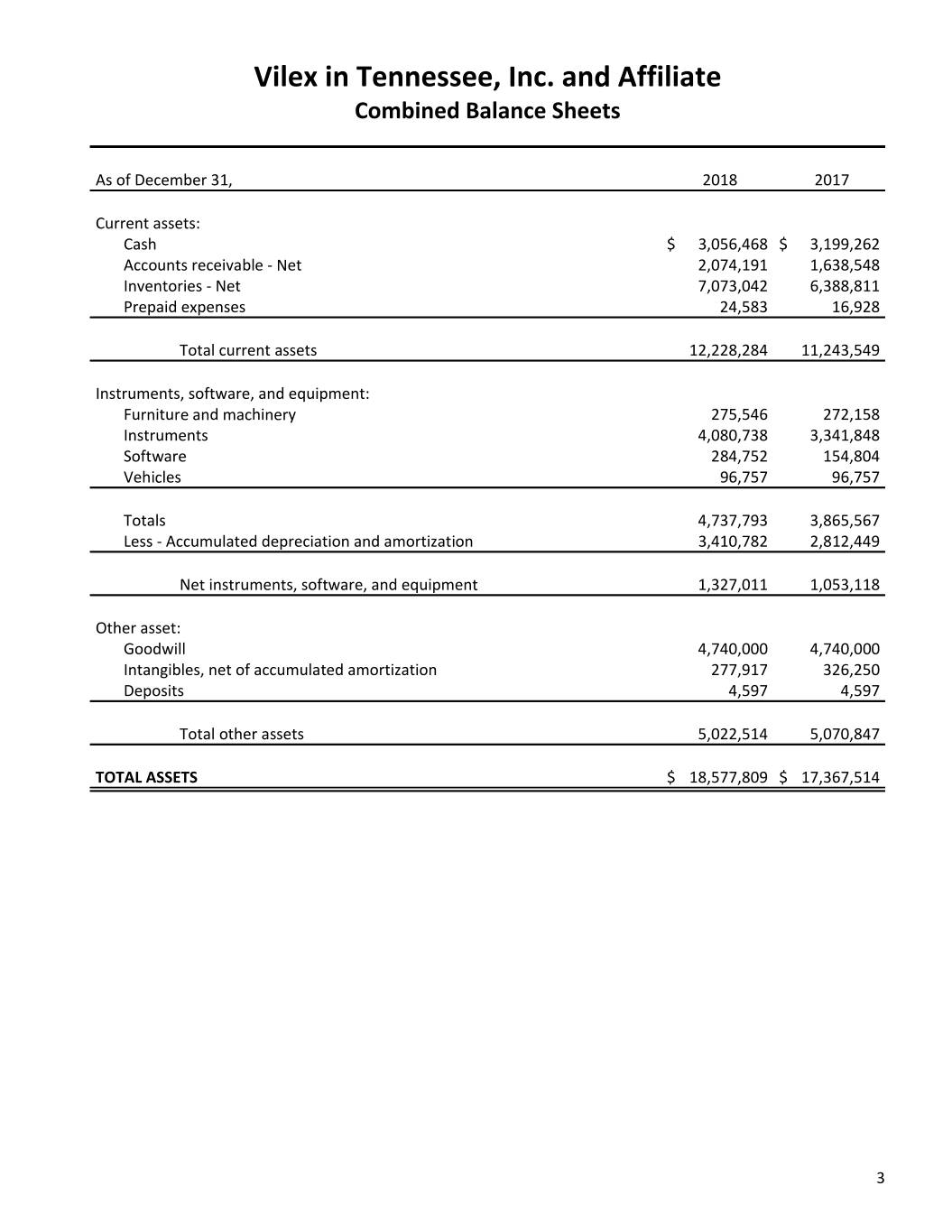
Vilex in Tennessee, Inc. and Affiliate Combined Balance Sheets As of December 31, 2018 2017 Current assets: Cash $ 3,056,468 $ 3,199,262 Accounts receivable - Net 2,074,191 1,638,548 Inventories - Net 7,073,042 6,388,811 Prepaid expenses 24,583 16,928 Total current assets 12,228,284 11,243,549 Instruments, software, and equipment: Furniture and machinery 275,546 272,158 Instruments 4,080,738 3,341,848 Software 284,752 154,804 Vehicles 96,757 96,757 Totals 4,737,793 3,865,567 Less - Accumulated depreciation and amortization 3,410,782 2,812,449 Net instruments, software, and equipment 1,327,011 1,053,118 Other asset: Goodwill 4,740,000 4,740,000 Intangibles, net of accumulated amortization 277,917 326,250 Deposits 4,597 4,597 Total other assets 5,022,514 5,070,847 TOTAL ASSETS $ 18,577,809 $ 17,367,514 3
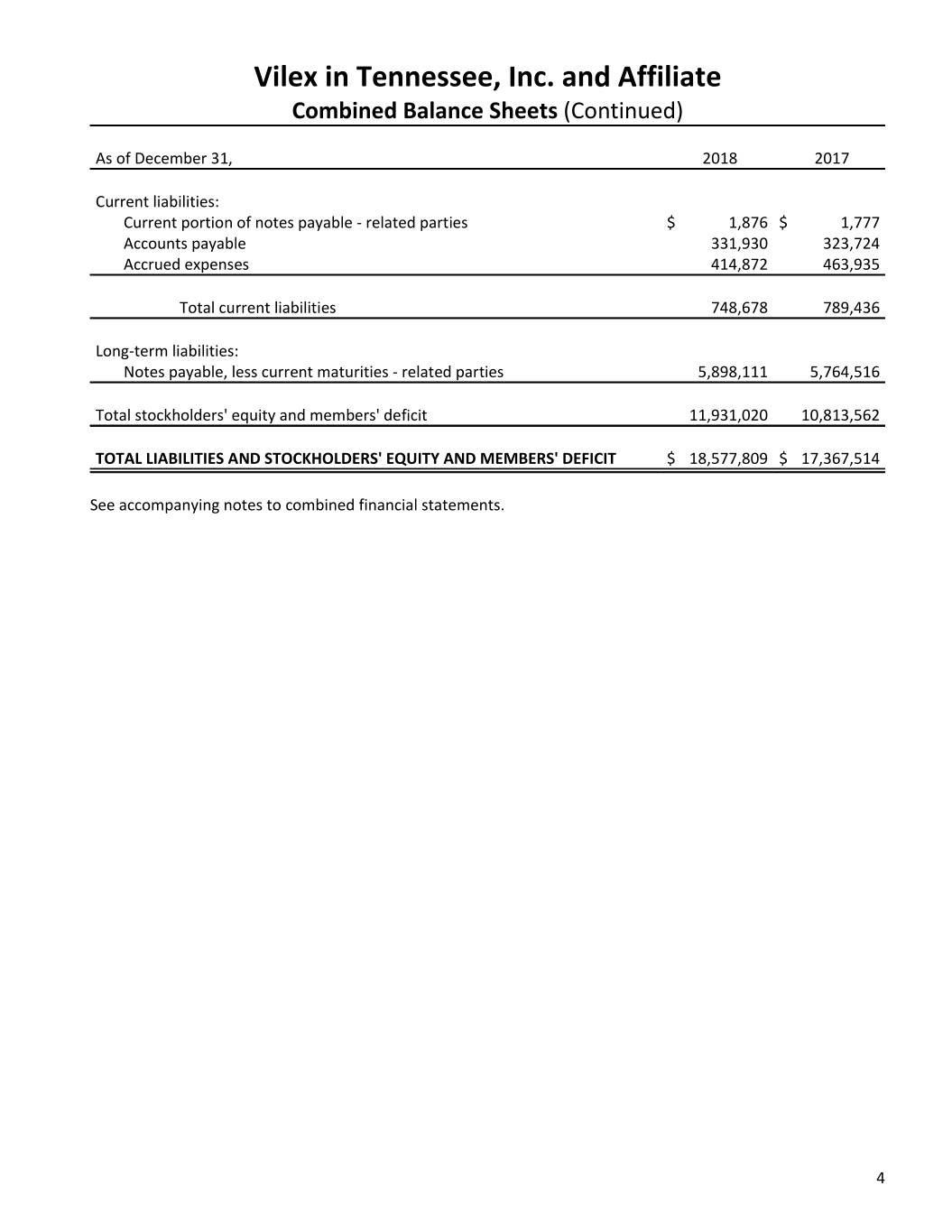
Vilex in Tennessee, Inc. and Affiliate Combined Balance Sheets (Continued) As of December 31, 2018 2017 Current liabilities: Current portion of notes payable - related parties $ 1,876 $ 1,777 Accounts payable 331,930 323,724 Accrued expenses 414,872 463,935 Total current liabilities 748,678 789,436 Long-term liabilities: Notes payable, less current maturities - related parties 5,898,111 5,764,516 Total stockholders' equity and members' deficit 11,931,020 10,813,562 TOTAL LIABILITIES AND STOCKHOLDERS' EQUITY AND MEMBERS' DEFICIT $ 18,577,809 $ 17,367,514 See accompanying notes to combined financial statements. 4
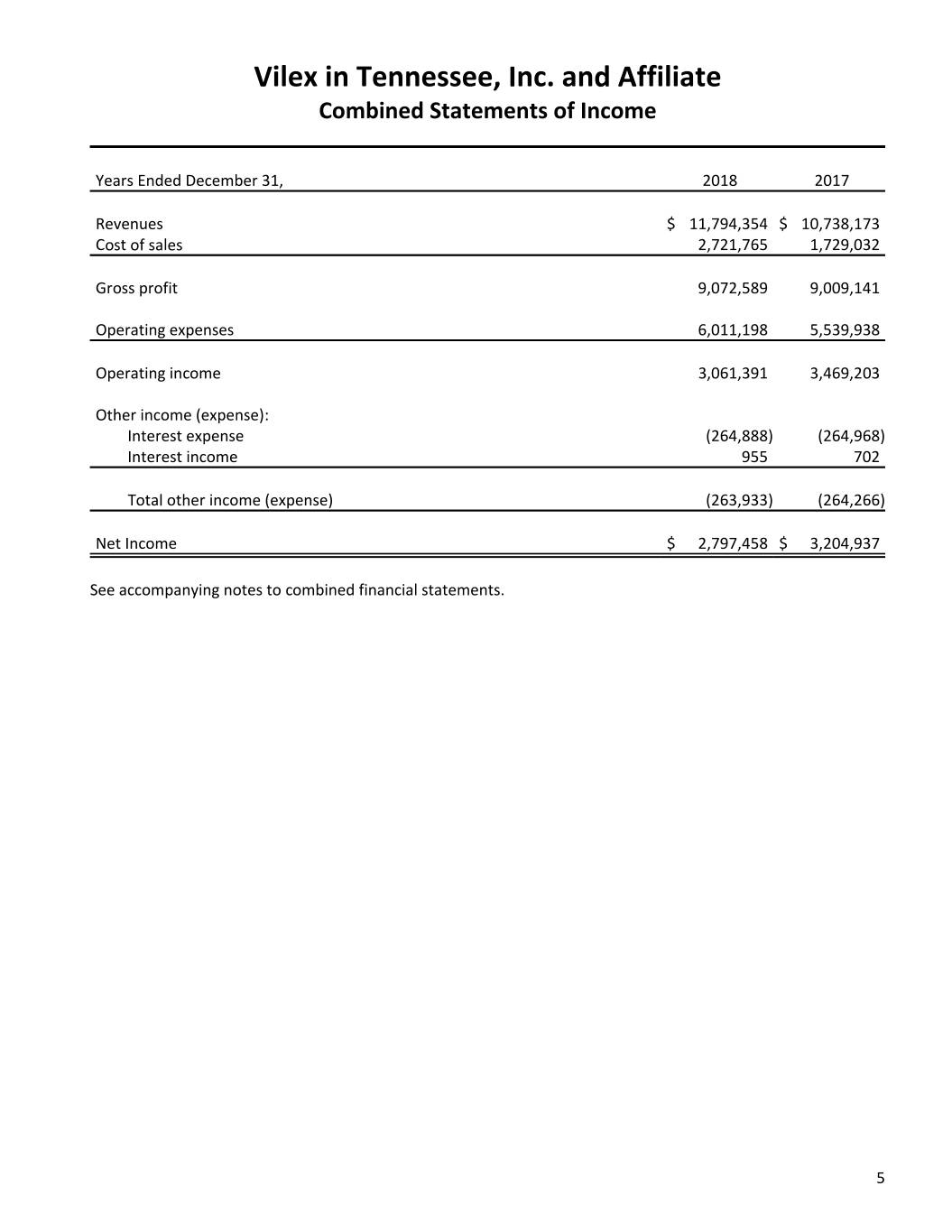
Vilex in Tennessee, Inc. and Affiliate Combined Statements of Income Years Ended December 31, 2018 2017 Revenues $ 11,794,354 $ 10,738,173 Cost of sales 2,721,765 1,729,032 Gross profit 9,072,589 9,009,141 Operating expenses 6,011,198 5,539,938 Operating income 3,061,391 3,469,203 Other income (expense): Interest expense (264,888) (264,968) Interest income 955 702 Total other income (expense) (263,933) (264,266) Net Income $ 2,797,458 $ 3,204,937 See accompanying notes to combined financial statements. 5
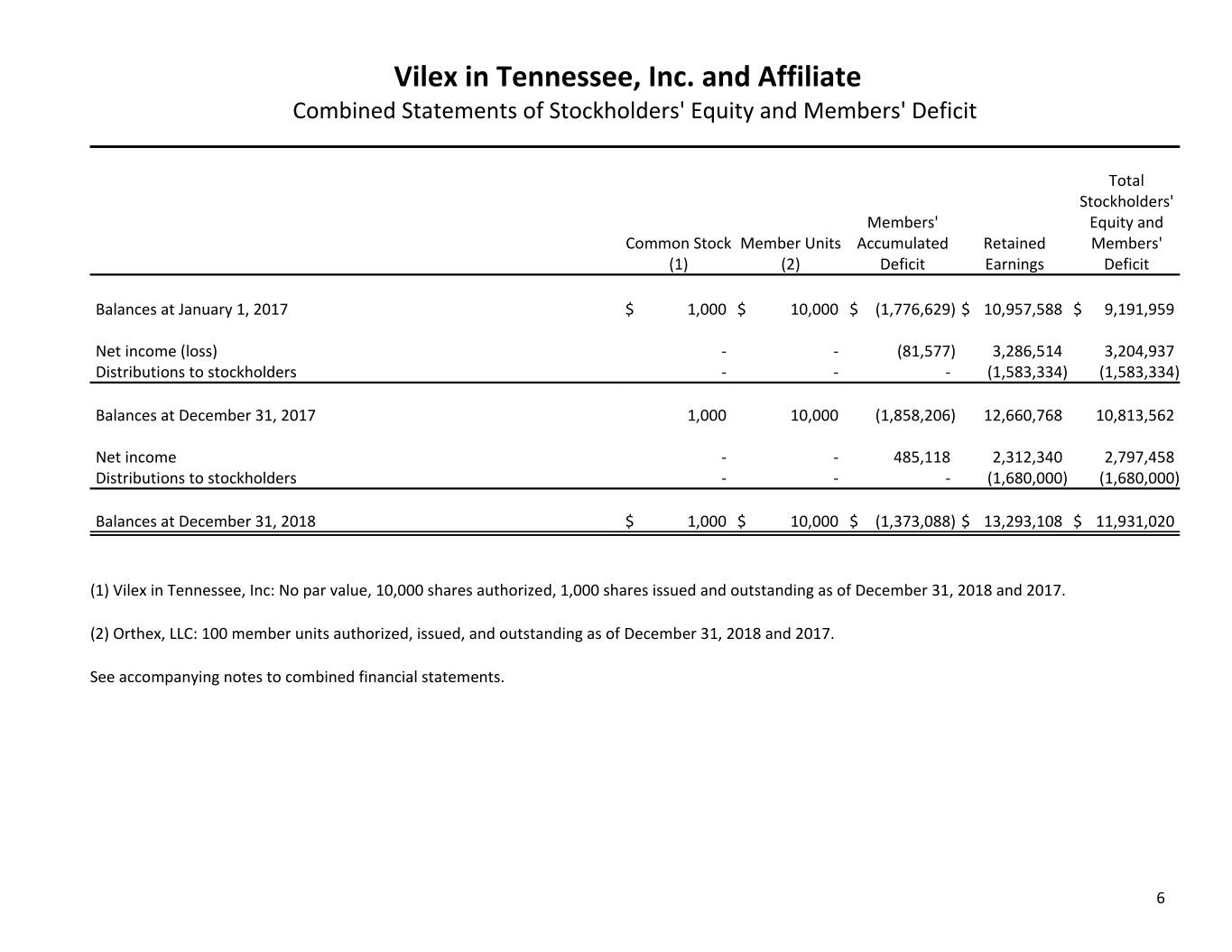
Vilex in Tennessee, Inc. and Affiliate Combined Statements of Stockholders' Equity and Members' Deficit Total Stockholders' Members' Equity and Common Stock Member Units Accumulated Retained Members' (1) (2) Deficit Earnings Deficit Balances at January 1, 2017 $ 1,000 $ 10,000 $ (1,776,629) $ 10,957,588 $ 9,191,959 Net income (loss) - - (81,577) 3,286,514 3,204,937 Distributions to stockholders - - - (1,583,334) (1,583,334) Balances at December 31, 2017 1,000 10,000 (1,858,206) 12,660,768 10,813,562 Net income - - 485,118 2,312,340 2,797,458 Distributions to stockholders - - - (1,680,000) (1,680,000) Balances at December 31, 2018 $ 1,000 $ 10,000 $ (1,373,088) $ 13,293,108 $ 11,931,020 (1) Vilex in Tennessee, Inc: No par value, 10,000 shares authorized, 1,000 shares issued and outstanding as of December 31, 2018 and 2017. (2) Orthex, LLC: 100 member units authorized, issued, and outstanding as of December 31, 2018 and 2017. See accompanying notes to combined financial statements. 6

Vilex in Tennessee, Inc. and Affiliate Combined Statements of Cash Flows Years Ended December 31, 2018 2017 Cash flows from operating activities: Net income $ 2,797,458 $ 3,204,937 Adjustments to reconcile net income to net cash provided by operating activities: Provision for depreciation and amortization 646,667 601,949 Changes in operating assets and liabilities: Accounts receivable (435,643) 205,293 Inventories (684,231) (1,173,159) Prepaid expenses (7,655) (3,828) Accounts payable 8,206 7,896 Accrued expenses (49,063) (140,445) Total adjustments (521,719) (502,294) Net cash provided by operating activities 2,275,739 2,702,643 Net cash used in investing activities: Acquisition of instruments, software, and equipment (872,226) (422,047) Cash flows from financing activities: Principal payments on notes payable - related parties (1,779) (1,698) Proceeds from issuance of notes payable - related parties 135,472 28,266 Distributions to stockholders (1,680,000) (1,583,334) Net cash used in financing activities (1,546,307) (1,556,766) Net change in cash (142,794) 723,830 Cash, beginning of year 3,199,262 2,475,432 Cash, end of year $ 3,056,468 $ 3,199,262 Supplemental cash flow information: Cash paid during the year for: Interest $ 264,888 $ 264,968 See accompanying notes to combined financial statements. 7

Vilex in Tennessee, Inc. and Affiliate Notes to Combined Financial Statements Note 1: Summary of Significant Accounting Policies Nature of Business The combined financial statements include the accounts of the following entities, collectively referred to as the "Companies" in the combined financial statements. Vilex in Tennessee, Inc. ("Vilex"), is a Tennessee Corporation that specializes as a high growth manufacturer of precision engineered extremity solutions for orthopedic surgery. Vilex is primarily a foot and ankle surgery company with a product portfolio targeting pediatric patients and adults. Vilex’s main facility is in McMinnville, Tennessee. Orthex, LLC ("Orthex"), is a Florida Limited Liability Company that specializes in designing and engineering external fixation and software products for use in orthopedic surgery and providing Vilex the opportunity to produce and distribute the products. Orthex operations occur in an engineering facility located in Hollywood, Florida. Principles of Combination The accompanying combined financial statements include the accounts of companies related under common ownership, which are operating as Vilex in Tennessee, Inc. and Affiliate, after elimination of significant intercompany accounts and transactions. Use of Estimates in Preparation of Combined Financial Statements The preparation of the accompanying combined financial statements in conformity with accounting principles generally accepted in the United States (GAAP) requires management to make certain estimates and assumptions that directly affect the results of reported amounts of assets, liabilities, revenues and expenses, as of the date of the combined financial statements. By their nature, these judgments are subject to an inherent degree of uncertainty. The use of historical experience and other assumptions is the basis for the judgments and estimates. Management considers the valuation of inventories, instruments, and goodwill to be significant estimates. Actual results may differ from these estimates. Accounts Receivable The Companies grant trade credit to its customers located throughout the United States and internationally. Receivables are valued at management's estimate of the amount that will ultimately be collected. The allowance for doubtful accounts is based on specific identification of uncollectible accounts and the Companies' historical collection experience. Balances that are still outstanding after management has used reasonable collection efforts are written off through a change to the valuation allowance and a credit to accounts receivable. An allowance of $343,000 and $90,000 was established as of December 31, 2018 and 2017, respectively, for the accounts receivable management believes may be uncollectible. 8
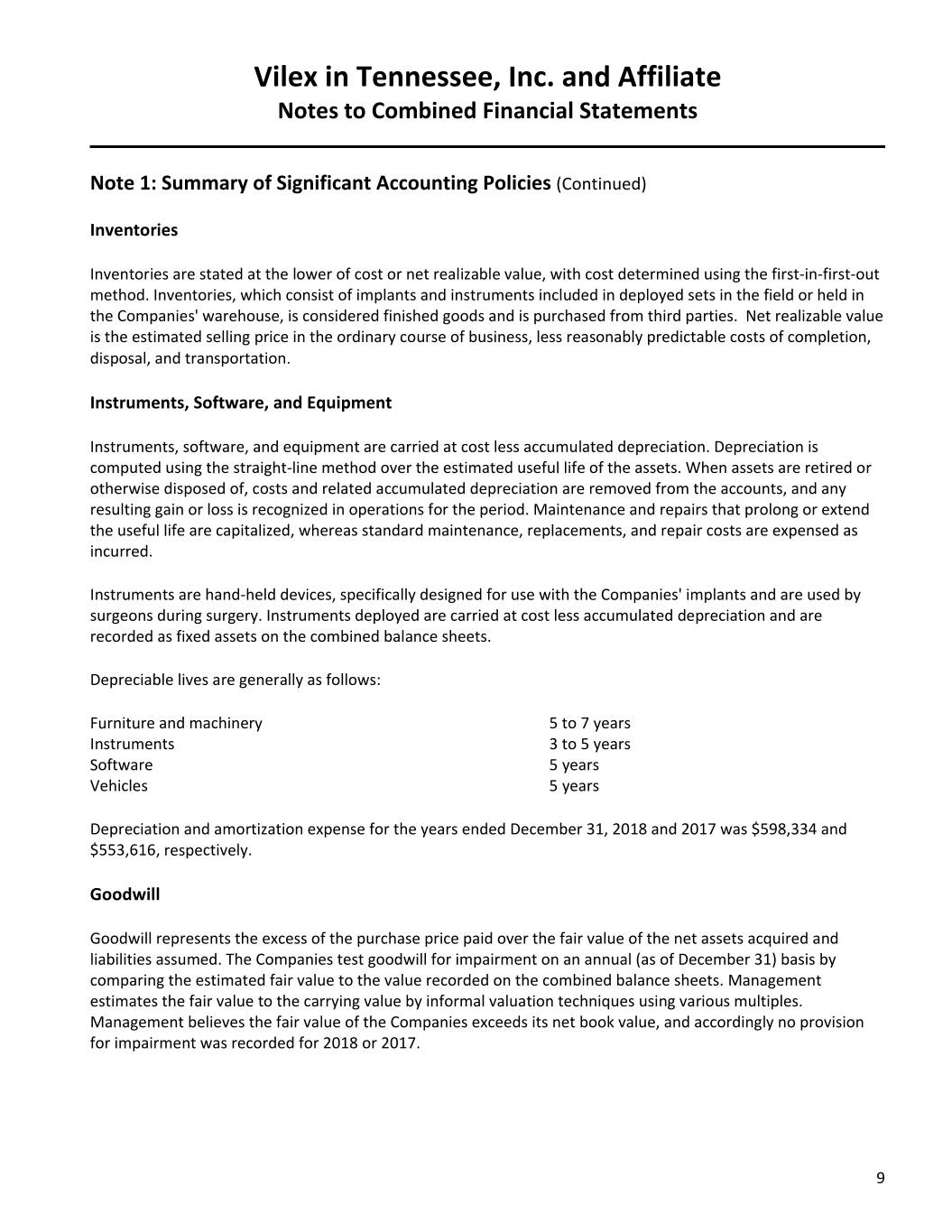
Vilex in Tennessee, Inc. and Affiliate Notes to Combined Financial Statements Note 1: Summary of Significant Accounting Policies (Continued) Inventories Inventories are stated at the lower of cost or net realizable value, with cost determined using the first-in-first-out method. Inventories, which consist of implants and instruments included in deployed sets in the field or held in the Companies' warehouse, is considered finished goods and is purchased from third parties. Net realizable value is the estimated selling price in the ordinary course of business, less reasonably predictable costs of completion, disposal, and transportation. Instruments, Software, and Equipment Instruments, software, and equipment are carried at cost less accumulated depreciation. Depreciation is computed using the straight-line method over the estimated useful life of the assets. When assets are retired or otherwise disposed of, costs and related accumulated depreciation are removed from the accounts, and any resulting gain or loss is recognized in operations for the period. Maintenance and repairs that prolong or extend the useful life are capitalized, whereas standard maintenance, replacements, and repair costs are expensed as incurred. Instruments are hand-held devices, specifically designed for use with the Companies' implants and are used by surgeons during surgery. Instruments deployed are carried at cost less accumulated depreciation and are recorded as fixed assets on the combined balance sheets. Depreciable lives are generally as follows: Furniture and machinery 5 to 7 years Instruments 3 to 5 years Software 5 years Vehicles 5 years Depreciation and amortization expense for the years ended December 31, 2018 and 2017 was $598,334 and $553,616, respectively. Goodwill Goodwill represents the excess of the purchase price paid over the fair value of the net assets acquired and liabilities assumed. The Companies test goodwill for impairment on an annual (as of December 31) basis by comparing the estimated fair value to the value recorded on the combined balance sheets. Management estimates the fair value to the carrying value by informal valuation techniques using various multiples. Management believes the fair value of the Companies exceeds its net book value, and accordingly no provision for impairment was recorded for 2018 or 2017. 9

Vilex in Tennessee, Inc. and Affiliate Notes to Combined Financial Statements Note 1: Summary of Significant Accounting Policies (Continued) Intangible Assets Intangible assets are made up of intellectual property that is amortized on a straight-line basis over the term of the asset which is 15 years. Amortization expense on intangible assets was $48,333 in both 2018 and 2017. Amortization expense for each of the next five years is $48,333. Long-Lived Assets The Companies review their long-lived assets periodically to determine potential impairment by comparing the carrying value of those assets with the estimated future undiscounted cash flows expected to result from the use of the assets, including cash flows from disposition. Should the sum of the expected future undiscounted cash flows be less than the carrying value, the Companies would recognize an impairment loss at that time. No impairment loss was recognized in 2018 or 2017. Revenue Recognition The Companies generate revenue primarily from the sale of their implants and instruments. The Companies primarily consign their implants and instrument sets to independent sales agencies, who in turn deliver them to hospitals for use in procedures. The Companies then supply these independent sales agencies with products to replace the consigned inventory as it is used in surgeries. The Companies primarily recognize revenue when the products are used by the hospital for surgeries on a case by case basis. On rare occasions, hospitals purchase products for their own inventory. In these situations, revenue is recognized when the products are shipped and the title and risk of loss passes to the hospital customer. Advertising Advertising is expensed as incurred. Advertising expense was $22,658 and $38,137 in 2018 and 2017, respectively. Research and Development Research and development costs are expensed as incurred. The Company considers that regulatory and other uncertainties inherent in the research and development of new products preclude it from capitalizing such costs. Research and development expenses totaled $261,428 and $205,431 in 2018 and 2017, respectively. 10

Vilex in Tennessee, Inc. and Affiliate Notes to Combined Financial Statements Note 1: Summary of Significant Accounting Policies (Continued) Income Taxes Vilex has elected to be taxed under the provisions of Subchapter S and Orthex has elected to be taxed as a partnership of the Internal Revenue Code and comparable state regulations. Under these provisions, neither Company pays federal or state corporate income taxes on its taxable income (nor is it allowed a net operating loss carryback or carryover as a deduction). Instead, the stockholders or members report on their personal income tax returns their proportionate share of the Company's taxable income (or loss) and tax credits. As a result of these elections, no income taxes have been recognized in the accompanying combined financial statements. The Companies have committed to making distributions sufficient to meet the stockholders' or members' income tax liabilities generated by the income of the Companies. The Companies assess the potential impact of uncertain tax positions. The Companies' policy for interest and penalties related to income tax exposures is to recognize interest and penalties as other income (expense) in the combined statements of income. As of December 31, 2018 and 2017, management believed the Companies had no material uncertain tax positions requiring recognition or measurement. The federal and state income tax returns remain open to examination by taxing authorities through their statutory periods. New Accounting Pronouncements In May 2014, the Financial Accounting Standards Board (FASB) issued Accounting Standards Update (ASU) No. 2014-09, Revenue from Contracts with Customers (Topic 606). This ASU, as amended, provides comprehensive guidance on the recognition of revenue from customers arising from the transfer of goods and services, guidance on accounting for certain contract costs, and new disclosures. The new standard supersedes current revenue recognition requirements in FASB Accounting Standards Codification (ASC) Topic 605, Revenue Recognition, and most industry-specific guidance. When adopted, the amendments in the ASU must be applied using one of two retrospective methods. ASU No. 2014-09 is effective for nonpublic companies for annual periods beginning after December 15, 2018. The Companies are currently evaluating the impact of the provisions of ASC 606. In February 2016, the Financial Accounting Standards Board (FASB) issued ASU No. 2016-02, Leases (Topic 842). This ASU modifies lease accounting to increase transparency and comparability by recognizing lease assets and lease liabilities on the balance sheet and disclosing key information about leasing information. The most significant change for lessees will be the recognition of both a liability to make lease payments (the lease liability) and a right-of-use asset representing its right to use the underlying asset for the lease term for those leases classified as operating leases under current GAAP. Certain accounting policy elections are permitted for leases with terms of 12 months or less. FASB Accounting Standards Codification (ASC) Topic 842, Leases (“ASC 842”), supersedes current lease requirements in FASB ASC Topic 840, Leases. When adopted, the amendments in the ASU must be applied using a modified retrospective approach, with certain practical expedients available. The new standard is effective for nonpublic companies for annual periods beginning after December 15, 2019. The Companies are currently evaluating the impact of the provisions of ASC 842. 11

Vilex in Tennessee, Inc. and Affiliate Notes to Combined Financial Statements Note 1: Summary of Significant Accounting Policies (Continued) Subsequent Events The Companies have evaluated subsequent events through July 30, 2019, which is the date the combined financial statements were available to be issued. See Note 9 for disclosure of subsequent events. Note 2: Inventories Inventories consisted of the following at December 31: Years Ended December 31 2018 2017 Inventory - Implants $ 4,374,917 $ 4,620,003 Inventory - Implants obsolescence (796,544) (865,722) Inventory - Consignment 4,210,444 3,174,133 Inventory - Consignment obsolescence (715,775) (539,603) Total $ 7,073,042 $ 6,388,811 The Companies evaluate the carrying value of the inventory in relation to the estimated forecast of product demand, which takes into consideration the life cycle of the product. A significant decrease in demand could result in an increase in the amount of excess inventory on hand, which could lead to additional charges for excess and obsolete inventory. The need to maintain substantial levels of inventory impacts the estimates for excess and obsolete inventory. Each of the implant systems are designed to include implantable products that come in different sizes and shapes to accommodate the surgeon’s needs. Typically, a small number of the set components are used in each surgical procedure. Certain components within each set may become obsolete before other components based on the usage patterns. The Companies adjust inventory values, as needed, to reflect these usage patterns and life cycle. In addition, the Companies continue to introduce new products, which may require additional charges for excess and obsolete inventory in the future. 12
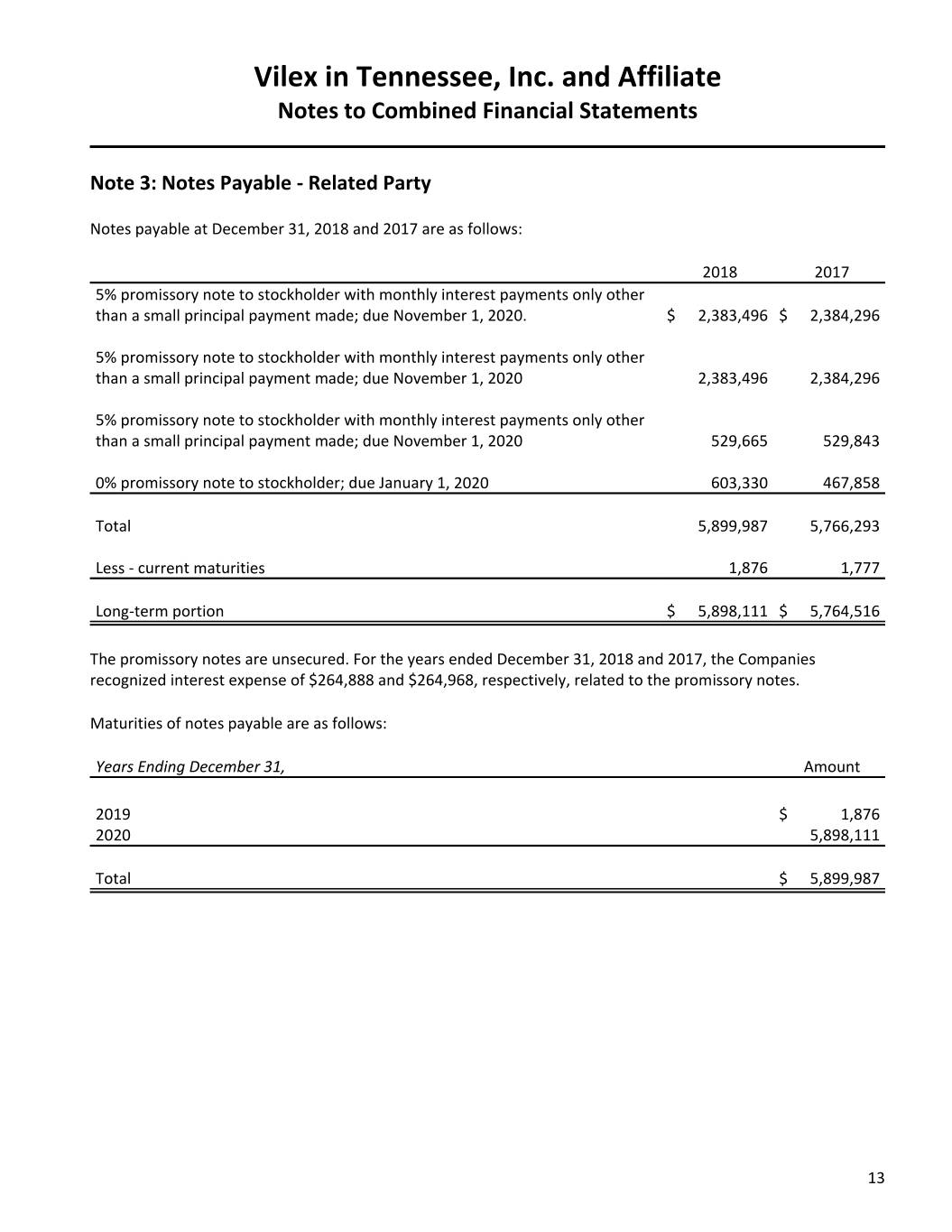
Vilex in Tennessee, Inc. and Affiliate Notes to Combined Financial Statements Note 3: Notes Payable - Related Party Notes payable at December 31, 2018 and 2017 are as follows: 2018 2017 5% promissory note to stockholder with monthly interest payments only other than a small principal payment made; due November 1, 2020. $ 2,383,496 $ 2,384,296 5% promissory note to stockholder with monthly interest payments only other than a small principal payment made; due November 1, 2020 2,383,496 2,384,296 5% promissory note to stockholder with monthly interest payments only other than a small principal payment made; due November 1, 2020 529,665 529,843 0% promissory note to stockholder; due January 1, 2020 603,330 467,858 Total 5,899,987 5,766,293 Less - current maturities 1,876 1,777 Long-term portion $ 5,898,111 $ 5,764,516 The promissory notes are unsecured. For the years ended December 31, 2018 and 2017, the Companies recognized interest expense of $264,888 and $264,968, respectively, related to the promissory notes. Maturities of notes payable are as follows: Years Ending December 31, Amount 2019 $ 1,876 2020 5,898,111 Total $ 5,899,987 13
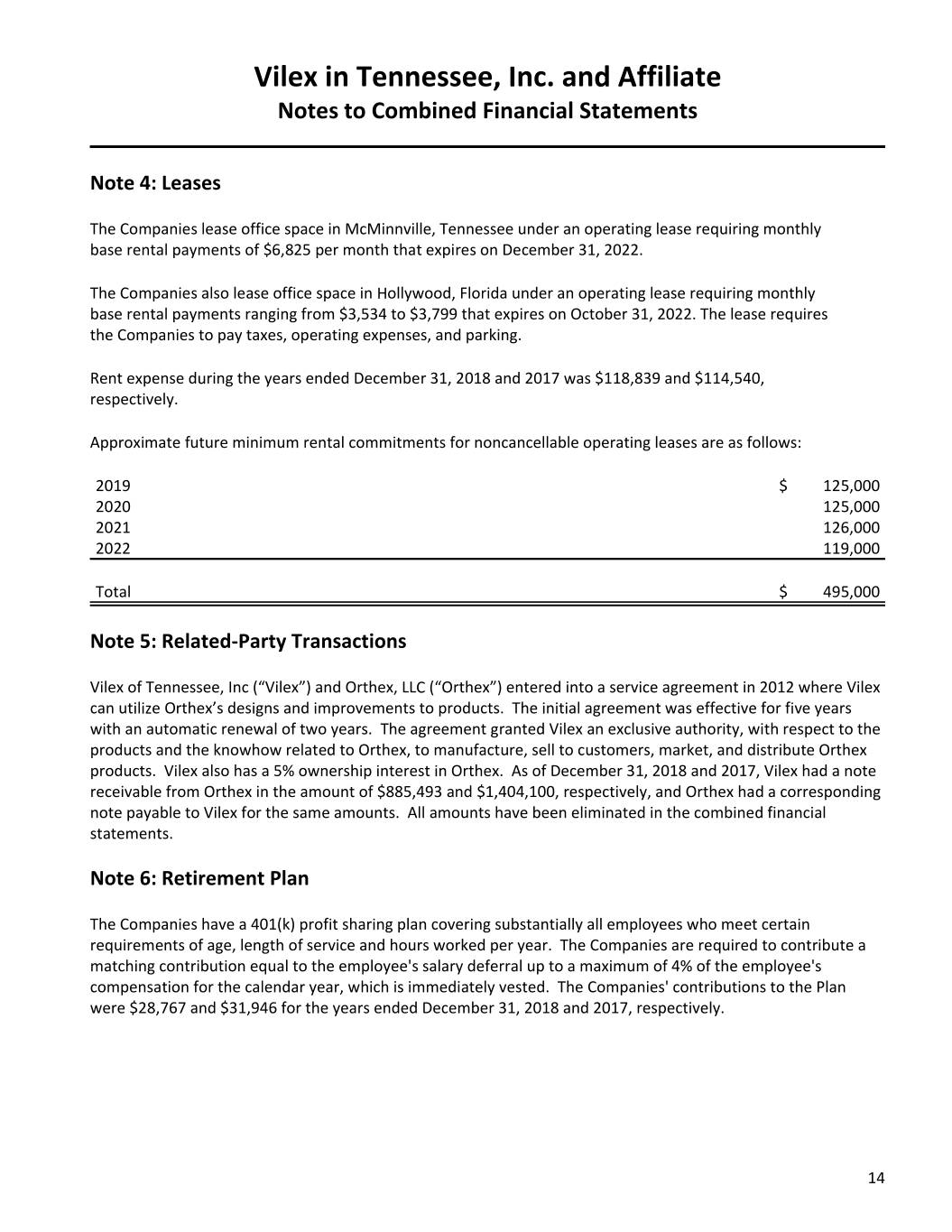
Vilex in Tennessee, Inc. and Affiliate Notes to Combined Financial Statements Note 4: Leases The Companies lease office space in McMinnville, Tennessee under an operating lease requiring monthly base rental payments of $6,825 per month that expires on December 31, 2022. The Companies also lease office space in Hollywood, Florida under an operating lease requiring monthly base rental payments ranging from $3,534 to $3,799 that expires on October 31, 2022. The lease requires the Companies to pay taxes, operating expenses, and parking. Rent expense during the years ended December 31, 2018 and 2017 was $118,839 and $114,540, respectively. Approximate future minimum rental commitments for noncancellable operating leases are as follows: 2019 $ 125,000 2020 125,000 2021 126,000 2022 119,000 Total $ 495,000 Note 5: Related-Party Transactions Vilex of Tennessee, Inc (“Vilex”) and Orthex, LLC (“Orthex”) entered into a service agreement in 2012 where Vilex can utilize Orthex’s designs and improvements to products. The initial agreement was effective for five years with an automatic renewal of two years. The agreement granted Vilex an exclusive authority, with respect to the products and the knowhow related to Orthex, to manufacture, sell to customers, market, and distribute Orthex products. Vilex also has a 5% ownership interest in Orthex. As of December 31, 2018 and 2017, Vilex had a note receivable from Orthex in the amount of $885,493 and $1,404,100, respectively, and Orthex had a corresponding note payable to Vilex for the same amounts. All amounts have been eliminated in the combined financial statements. Note 6: Retirement Plan The Companies have a 401(k) profit sharing plan covering substantially all employees who meet certain requirements of age, length of service and hours worked per year. The Companies are required to contribute a matching contribution equal to the employee's salary deferral up to a maximum of 4% of the employee's compensation for the calendar year, which is immediately vested. The Companies' contributions to the Plan were $28,767 and $31,946 for the years ended December 31, 2018 and 2017, respectively. 14

Vilex in Tennessee, Inc. and Affiliate Notes to Combined Financial Statements Note 7: Major Customers In 2018 and 2017, one major customer accounted for 18% of revenues in each year. At December 31, 2018 and 2017, amounts due from the customer, included in accounts receivable were approximately $111,000 and $102,000, respectively. Note 8: Concentration of Credit Risk The Companies have cash accounts with balances held by one financial institution that at times exceed the Federal Deposit Insurance Corporation (FDIC) limits. Management believes the financial institution with which they do business has a strong credit rating and that the credit risk related to the Companies' deposits is minimal. The Companies grant credit to their customers without collateral in the normal course of business. During the years ended December 31, 2018 and 2017, the Companies had net write-offs of approximately $98,000 and $63,000, respectively. Note 9: Subsequent Event Effective June 4, 2019, the Companies were acquired by OrthoPediatrics, a company focused exclusively on advancing the field of pediatric orthopedics. The acquisition included its Orthex Hexapod circular fixation technology and proprietary CORA-based x-ray planning software. The acquisition was for a total of $60,000,000, consisting of $50,000,000 in cash and $10,000,000 in OrthoPediatrics stock. 15














